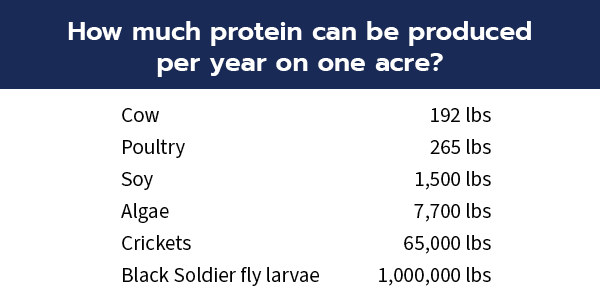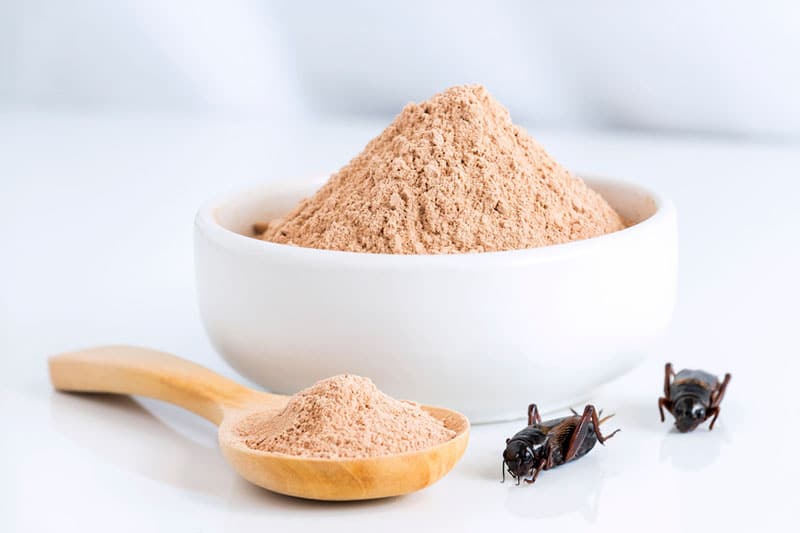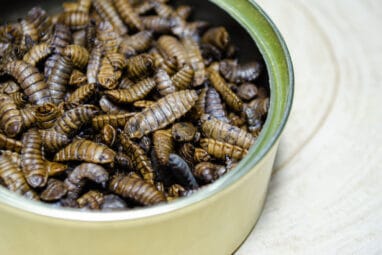The current world population of 7.6 billion will reach an estimated 9.8 billion in 2050, according to the United Nations. To meet protein demand, farm production of primary proteins will need to grow from 525 million tons to 790 million tons annually. Concern for having enough food to support projected global population growth has led to high interest among scientists, governmental agencies, and food producers on alternative sources of protein, including plants and insect proteins.
Perhaps you’re wondering whether insects in pet food is an emerging fad or an enduring trend. Meanwhile, you occasionally see an article or news on a small aspect of this vast and complex topic. But what’s the big picture?
In this two-blog post series, we will attempt to distill a myriad of information on the topic into a mini status report—basically, our synopsis of what’s happening and what’s coming.
Let’s start with the role insect proteins can play as an alternative to meat protein.
Insect farming: an ancient occupation opens a path to the future
Sustainability of future protein sources has been the catalyst driving development of an insect protein industry to serve the food needs of people and pets.
In addition to requiring substantial land water and resources, producing meat is a large source of carbon emissions. Since about one-fourth of the world’s meat production goes to feeding pets, advocates of alternative sources of protein are focusing much of their attention on the pet food supply chain.
Consumable meats from cattle, poultry and other livestock require substantially more food, water and land resources than similar amounts of protein produced from insect farming.
Insect farms are efficient, sustainable, and require only a small footprint of land. With insects’ rapid time-to-maturity and high reproduction rates, they can produce very high yields of protein.
Cattle has twice as much protein per pound of product as crickets. However, to produce the same amounts of protein as crickets, cattle need 12 times the amount of feed. The multipliers for sheep, chicken and swine are 4, 2 and 2, respectively.
According to the Food and Agriculture Organization (FAO) of the United Nations, there are more than 20,000 insect farmers worldwide, and more than 1,900 insect species have reportedly been used as food.
What are the advantages of using insects as a protein source?
Insects, which are considered animals, are a complete animal protein with all nine essential amino acids. According to the FAO, “the nutritional value of insects does not differ from the nutritional value of other meat sources such as chicken, beef, pork and fish.”
In a study of five insects, all had higher scores for total indispensable amino acids than chicken meal.
Insects also scored higher than chicken meal for digestibility.
Insects offer many additional benefits, such as:
- Insects are packed with vitamins and minerals, which the body can absorb at a faster rate than beef or wheat.
- Insects have a high content of antioxidants, which help protect the body from cell damage caused by free radicals.
- Edible insects are a great source of essential fatty acids. Many insects provide an optimal Omega 3:6 balance.
- Chitlin, the exoskeleton of an insect, is a prebiotic fiber—the food for the “good” bacteria that can travel deep into human or pet intestines.
While a variety of insect species are being used worldwide for human and animal consumption, the primary insect being used globally in pet foods is black soldier fly (BSF) larvae. BSF larvae is considered an excellent complement to meat-based protein sources in a complete and balanced pet food.
BSF larvae absorb food and water from fruits, grains and vegetables that would otherwise go to waste. According to Bühler Insect Technology Solution, the environmental advantages of BSF larvae stack up remarkably well compared to chickens. Producing chickens requires about 13 times more land, 7 times more water, 5.5 times more CO2 emissions, and 1.5 times more energy. Jiminy’s, a California firm that makes dog food and treats from black soldier fly larvae and crickets, features this information on its website:

Are there any disadvantages?
Some researchers have warned about the lack of knowledge on insect farming. If a non-native species escaped an insect farm, researchers say, there could be severe environmental damage.
Insect proteins are being used in livestock feed, raising a troublesome issue: Are insects a catalyst for extending livestock production rather than replacing it? An animal welfare newsletter stated, “Insect farming isn’t an alternative to factory farming — it’s a supplier. The fabled efficiency of insects is thus a red herring. Feeding corn to insects, then feeding them to chickens, is inherently less efficient than just feeding the corn to chickens.”
A 2020 paper by two animal nutrition scientists, G. Bosch and K.S. Swanson, provided an overview of the current state of knowledge on the use of insects as feed for dogs and cats. The paper highlighted various research voids, including these:
- Private companies have likely studied the palatability of their insect-based products, but few have made data available to the public.
- No public studies evaluated the effectiveness of insect-based hypoallergenic foods in affected dogs or cats.
- Stool quality consistency has been studied, but research on other stool quality attributes is lacking.
Bosch and Swanson concluded, “Multiple studies evaluated aspects of the nutritional quality of various insect species but the impact of long-term feeding on the nutritional status and health in dogs and cats are still largely unexplored.”
The authors also pointed out some benchmarking flaws in generalized claims that insects are a sustainable protein source.
Other researchers note that there are risks associated with eating insects not produced in controlled and defined conditions. Insects can contain toxins, bacteria, pesticides, allergens and anti-nutrients. More research is needed, but the amounts of these contaminants appear to be minimal, are within ranges commonly seen in meats and grains, and are mostly eliminated during production stages.
[Revised Jun 30, 2022]
Anne Carlson, founder and CEO of Jiminy’s, points to additional research and articles that help reduce concerns about the lack of research mentioned above on using insects in pet foods:
- 2022 paper by Enviroflight reviews more recent research on insect digestibility in pet foods.
- 2021 palatability study by Enterra found that dogs strongly preferred a diet containing black soldier fly ingredients over a diet containing plant protein.
- 2018 study examined the effects of an insect-containing diet on 20 dogs with atopic dermatitis.
- 2018 study that tested the effects of diets containing up to 24% cricket on the gut microbiome of dogs.
Step up the research, scientists say
Peer-reviewed research for publication and private research is rapidly evolving on insect protein for pets. However, many aspects of insect-based pet foods need more research.
For years, the United Nations has taken a leadership role in promoting insects as a sustainable food source for humans. In 2013, the Food and Agriculture Organization (FAO) of the United Nations published Edible insects: Future prospects for food and feed security. Drawing upon a wide range of scientific research, the book raised international awareness on the contributions edible insects can make in meeting the food needs of a growing world population.
The FAO has followed up with additional publications. Guidance on sustainable cricket farming, published in 2020, is a comprehensive manual of best practices for farming crickets. Looking at edible insects from a food safety perspective, published in 2021, analyzes the food safety implications associated with edible insects.
The Bosch and Swanson paper mentioned earlier reviewed what is known about naturalness, palatability, nutritional quality, health effects, and sustainability of insects as feed for dogs and cats. In the paper, titled Effect of using insects as feed on animals: pet dogs and cats, the authors stated,
“Trends in human food are often rapidly translated into new pet food products. Insects have received considerable attention as a sustainable and sometimes even health-promoting and novel protein source for humans. The ‘buzz’ in society around insects has also resulted in the appearance of insect-based pet food products on the market and more products are on their way.”
Commercial pet foods marketed as being nutritionally complete should support the health of a dog or cat over the long-term, the authors stated. They reviewed many studies evaluating aspects of the nutritional quality of various insect species. However, they noted a glaring lack of research on the nutritional and health impacts of feeding insect-based protein to pets over a long term.
Meanwhile, new studies may already be filling some of the research gaps. In 2021, the journal Animals published a study showing that crickets or mulberry silkworms may be safe substitutes for poultry meal in dog food. Over the next few years, market acceptance of insect-based proteins in pet food will hinge on better research and regulatory approvals.
Click here to read part 2 of this two-part series.


